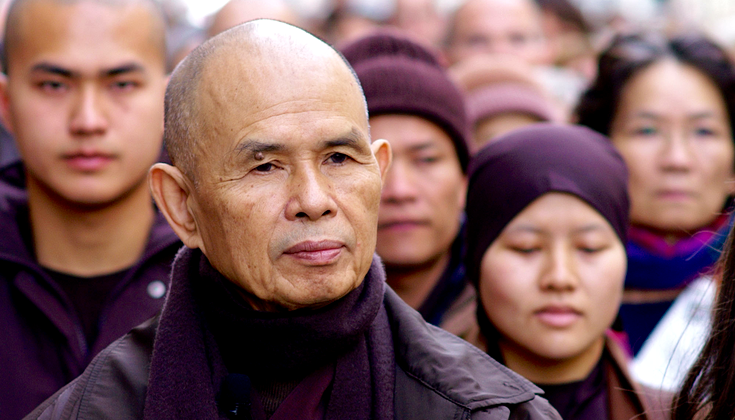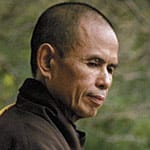Beginning Anew is not to ask for forgiveness. Beginning Anew is to change your mind and heart, to transform the ignorance that brought about wrong actions of body, speech, and mind, and to help you cultivate your mind of love. Your shame and guilt will disappear, and you will begin to experience the joy of being alive. All wrongdoings arise in the mind. It is through the mind that wrongdoings can disappear.
At Plum Village, we practice a ceremony of Beginning Anew every week. Everyone sits in a circle with a vase of fresh flowers in the center, and we follow our breathing as we wait for the facilitator to begin.
Your shame and guilt will disappear, and you will begin to experience the joy of being alive. All wrongdoings arise in the mind. It is through the mind that wrongdoings can disappear.
The ceremony has three parts: flower watering, expressing regrets, and expressing hurts and difficulties. This practice can prevent feelings of hurt from building up over the weeks and helps make the situation safe for everyone in the community.
We begin with flower watering. When someone is ready to speak, she joins her palms and the others join their palms to show that she has the right to speak. Then she stands, walks slowly to the flower, takes the vase in her hands, and returns to her seat. When she speaks, her words reflect the freshness and beauty of the flower that is in her hand.
During flower watering, each speaker acknowledges the wholesome, wonderful qualities of the others. It is not flattery; we always speak the truth. Everyone has some strong points that can be seen with awareness. No one can interrupt the person holding the flower. She is allowed as much time as she needs, and everyone else practices deep listening.
When she is finished speaking, she stands up and slowly returns the vase to the center of the room.
In the second part of the ceremony, we express regrets for anything we have done to hurt others. It does not take more than one thoughtless phrase to hurt someone. The ceremony of Beginning Anew is an opportunity for us to recall some regret from earlier in the week and undo it.
In the third part of the ceremony, we express ways in which others have hurt us. Loving speech is crucial. We want to heal the community, not harm it. We speak frankly, but we do not want to be destructive. Listening meditation is an important part of the practice. When we sit among a circle of friends who are all practicing deep listening, our speech becomes more beautiful and more constructive. We never blame or argue.
Compassionate listening is crucial. We listen with the willingness to relieve the suffering of the other person, not to judge or argue with her. We listen with all our attention. Even if we hear something that is not true, we continue to listen deeply so the other person can express her pain and release the tensions within herself. If we reply to her or correct her, the practice will not bear fruit. We just listen. If we need to tell the other person that her perception was not correct, we can do that a few days later, privately and calmly. Then, at the next Beginning Anew session, she may be the person who rectifies the error and we will not have to say anything. We close the ceremony with a song or by holding hands with everyone in the circle and breathing for a minute. Sometimes we end with hugging meditation.
Hugging meditation is a practice I invented. In 1966, a woman poet took me to the Atlanta Airport and then asked, “Is it all right to hug a Buddhist monk?” In my country, we are not used to expressing ourselves that way, but I thought, “I am a Zen teacher. It should be no problem for me to do that.” So I said, “Why not?” and she hugged me. But I was quite stiff. While on the plane, I decided that if I wanted to work with friends in the West, I would have to learn the culture of the West, so I invented hugging meditation.
Hugging meditation is a combination of East and West. According to the practice, you have to really hug the person you are hugging. You have to make him or her very real in your arms, not just for the sake of appearances, patting him on the back to pretend you are there, but breathing consciously and hugging with all your body, spirit, and heart. Hugging meditation is a practice of mindfulness. “Breathing in, I know my dear one is in my arms, alive. Breathing out, she is so precious to me.” If you breathe deeply like that, holding the person you love, the energy of care, love, and mindfulness will penetrate into that person and she will be nourished and bloom like a flower.
At a retreat for psychotherapists in Colorado, we practiced hugging meditation, and one retreatant, when he returned home to Philadelphia, hugged his wife at the airport in a way he had never hugged her before. To be really there, you only need to breathe mindfully, and suddenly both of you become real. It may be one of the best moments in your life.
After the Beginning Anew ceremony, everyone in the community feels light and relieved, even if we have taken only preliminary steps toward healing. We have confidence that, having begun, we can continue. This practice dates to the time of the Buddha, when communities of monks and nuns practiced Beginning Anew on the eve of every full moon and new moon. I hope you will practice Beginning Anew in your own family every week.
From Teachings on Love, by Thich Nhat Hanh. © 1998. Reprinted with permission of Parallax Press, Berkeley, CA.

